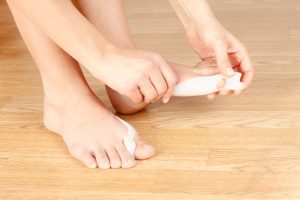Dr. Brian Nagy | October 17th, 2017
Posted In: Bunions
 Bunions are a common foot disorder, with 23% of Americans over the age of 18 and 36% over the age of 65 living with painful bony bumps on the joint between their big toe and the rest of their foot. In many cases, you can take care of your feet with some minor lifestyle adjustments and simple at-home care. Especially if you notice the bunion at an early stage when at home treatment can manage the condition and prevent it from worsening.
Bunions are a common foot disorder, with 23% of Americans over the age of 18 and 36% over the age of 65 living with painful bony bumps on the joint between their big toe and the rest of their foot. In many cases, you can take care of your feet with some minor lifestyle adjustments and simple at-home care. Especially if you notice the bunion at an early stage when at home treatment can manage the condition and prevent it from worsening.
Bunions are caused by a deformity that causes your big toe to bend toward your other toes. This puts pressure on its joint with the rest of the foot, pushing it out. This causes a bump to form where the joint is pushed out of position. Without effective bunion treatment, the deformity becomes more and more painful and can make it difficult or even impossible for you to walk.
Initially, a bunion is just a bump on the side of your big toe joint. It might be a little red because it will rub against the inside of your shoe. You might have a callous. If you notice these symptoms, you should make an appointment with your trusted podiatrist. A simple examination will help your foot doctor decide on how to treat the bunion and preserve the health of your feet.
One of the first suggestions for bunion treatment your podiatrist will make is to change your shoes. Women especially are guilty of wearing shoes that squish their toes together. If you start to develop bunions, you should change to shoes with a wider toe box and a flat or low heel to reduce the pressure on the joints of your toes.
You should not stop exercising. If your bunion causes pain when you exercise, switch to an activity that doesn’t put so much pressure on your feet, like swimming, cycling or using the elliptical machine instead of a treadmill.
You can also use bunion pads, arch supports or orthotics. These devices support your feet and help to improve alignment and functionality which can slow the development of bunions.
If you experience bunion pain, you can try some conservative at home treatments. You may find that over-the-counter pain medication like non-steroidal anti-inflammatory drugs can help to relieve pain. Some patients find that applying ice for about 20 minutes and elevating the affected foot can reduce painful symptoms.
You can also use moleskin on the insides of your shoes to reduce friction on pressure areas. If you have shoes that are tight in the toe box, you can sometimes have the shoe stretched. Some cobblers are able to safely stretch and soften hard leather.
Some people are genetically pre-dispositioned to develop bunions and even with diligent at-home bunion treatment, will still develop painful and progressively more severe deformities. In this case, more active care from your trusted New Hampshire podiatrist may be necessary. Some of the signs that you need to return to your foot doctor for additional care may include:
Your podiatrist can provide more comprehensive care to treat your bunions and keep you active and on your feet. It is rare, but in some cases, more invasive treatments or even surgery might be needed to restore your foot and realign your toe.
If you are concerned about bunions or have questions about this common foot disorder, make an appointment with Dr. Nagy and the team at Nagy Footcare. Healthy feet are critical to your overall wellbeing, so don’t put off taking care of your feet and getting professional advice.
« What Foot Problems May Reveal About How Well You Take Care of Yourself | Does Your Child Suffer from Flat Feet That Results in Foot Pain? »